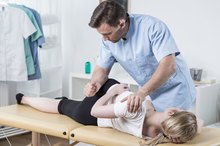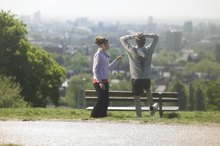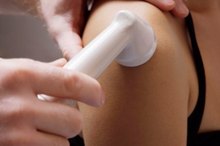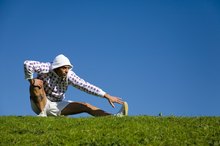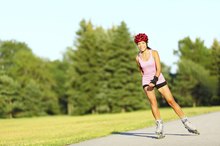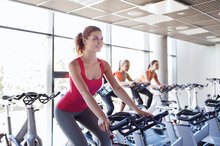Can Inversion Tables Help Scoliosis?
Scoliosis is a physical defect in the spine that causes it to curve from side to side, making it appear like it forms an S- or C-shape rather than a straight line when a person is viewed from behind. In severe cases, scoliosis must be treated with surgery, but in more mild cases a physical therapy regimen may be prescribed by your physician. One type of physical therapy that is not often used but may have mild positive effects is inversion therapy.
Pain Relief
Stretching is a common exercise on an inversion table and it may offer temporary pain relief for people with scoliosis. While you are inverted on the table, the effects of gravity are reversed on your spine and your body becomes elongated. Repeatedly entering an inverted state is believed to force fresh blood through your muscles and fluid into your spinal discs. This is believed to provide temporary pain relief in the hours following inversion therapy, but will not likely have a permanent effect.
- Stretching is a common exercise on an inversion table and it may offer temporary pain relief for people with scoliosis.
Posture Correction
Spinalis Thoracis and Exercise
Learn More
Inversion therapy is believed by some to aid in posture correction, which can be beneficial if you have scoliosis. According to the Sports Injury Clinic website, increased blood flow to your muscles helps to reduce back spasms. The reduction of these spasms may help in the realignment of the spine and thus improve posture without painful braces. However, there is not much scientific research to back the validity of the assumption that regular inversion therapy will help your posture.
- Inversion therapy is believed by some to aid in posture correction, which can be beneficial if you have scoliosis.
- The reduction of these spasms may help in the realignment of the spine and thus improve posture without painful braces.
Abdominal Strengthening
The rectus abdominis is the sectioned muscle that covers your stomach and forms what is commonly known as the six-pack. This muscle is partly responsible for the forward movement of your spine. Inversion tables can be used to perform sit-ups and crunches that strengthen your rectus abdominis. This in turn will help you sit and stand straighter without tiring. The greater the inversion you undertake, the more you will gain muscle in your abdomen from exercising.
- The rectus abdominis is the sectioned muscle that covers your stomach and forms what is commonly known as the six-pack.
- This muscle is partly responsible for the forward movement of your spine.
Potential
Tensor Fasciae Latae Muscle Stretches
Learn More
Unfortunately, scoliosis is a complex disease that is affected by many unknown factors on a patient-to-patient basis. According to the National Scoliosis Foundation, 85 percent of scoliosis cases are classified as idiopathic, meaning that the causes are largely unknown. Research into inversion therapy and spinal traction to treat scoliosis is limited. This type of therapy may bring temporary relief to patients, but should only be used as part of a wider treatment plan designed by your physician.
- Unfortunately, scoliosis is a complex disease that is affected by many unknown factors on a patient-to-patient basis.
- According to the National Scoliosis Foundation, 85 percent of scoliosis cases are classified as idiopathic, meaning that the causes are largely unknown.
Related Articles
References
- Bodybuilding.com: Abs--Exercises, Anatomy and Tips
- Sports Injury Clinic: Inversion Therapy
- Spine Universe: Turning Back Pain and Sciatica Upside Down
- Mayo Clinic: Inversion Therapy--Can It Relieve Back Pain?
- National Scoliosis Foundation: Information and Support
- Mayo Clinic: Scoliosis--Treatment and Drugs
- Chronic Back Pain. Health Policy Institute. https://hpi.georgetown.edu/backpain/. Published February 13, 2019.
- Wegner I, Widyahening IS, Van tulder MW, et al. Traction for low-back pain with or without sciatica. Cochrane Database Syst Rev. 2013;(8):CD003010. doi:10.1002/14651858.CD003010.pub5
- McMonnies CW. Intraocular pressure and glaucoma: Is physical exercise beneficial or a risk?. J Optom. 2016;9(3):139–147. doi:10.1016/j.optom.2015.12.001
- Chronic Back Pain. Health Policy Institute. Published February 13, 2019.
- Kong L, Tian W, Cao P, Wang H, Zhang B, Shen Y. Predictive factors associated with neck pain in patients with cervical disc degeneration: A cross-sectional study focusing on Modic changes. Medicine (Baltimore). 2017;96(43):e8447. doi:10.1097/MD.0000000000008447
Writer Bio
Writing professionally since 2005, Ryan Haas specializes in sports, politics and music. His work has appeared in "The Journal-Standard," SKNVibes and trackalerts. Haas holds a Bachelor of Arts in English and creative writing from the University of Illinois.
